Home > Article > Web Front-end > Detailed introduction to JavaScript binary trees and various traversal algorithms
This article brings you relevant knowledge about javascript. It mainly introduces the details of JavaScript binary trees and various traversal algorithms. The article provides a detailed introduction around the topic, which has certain reference value. Friends who need it can refer to it. I hope it will be helpful to everyone.

[Related recommendations: javascript video tutorial, web front-end】
A binary tree is a tree in which each node can only have at most two child nodes, as shown in the following figure:
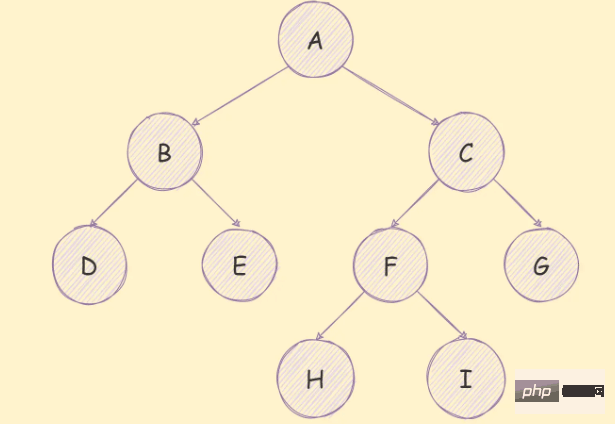
A binary tree has The following characteristics:
2^(i-1) nodes at the i layer; k, then the binary tree has at most 2^k-1 nodes; n0 to represent the number of leaf nodes, and n2 to be the number of non-leaf nodes with degree 2, then the two satisfy the relationship n0 = n2 1. If in a binary tree, Except for the leaf nodes, each degree of the remaining nodes is 2, then the binary tree is a full binary tree,
As shown in the figure below:
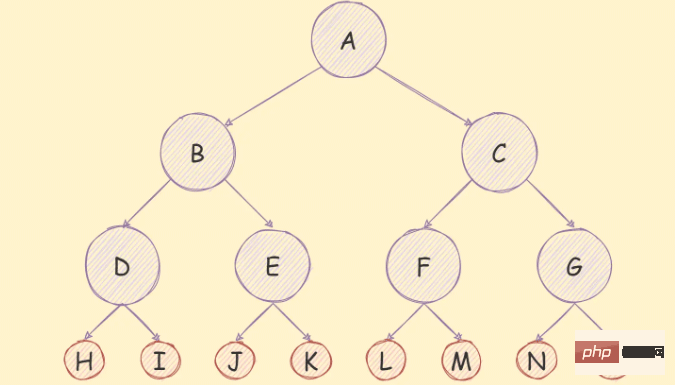
## In addition to satisfying the characteristics of ordinary binary trees, a full binary tree also has the following features: Characteristics:
th level of a full binary tree has 2^(n-1) nodes;
must have 2^k-1 nodes, and the number of leaf nodes is 2^(k-1);
nodes is log_2^(n 1).
If a binary tree is a full binary tree after removing the last layer, and the last node is distributed from left to right, then this A binary tree is a complete binary tree,
As shown in the figure below:
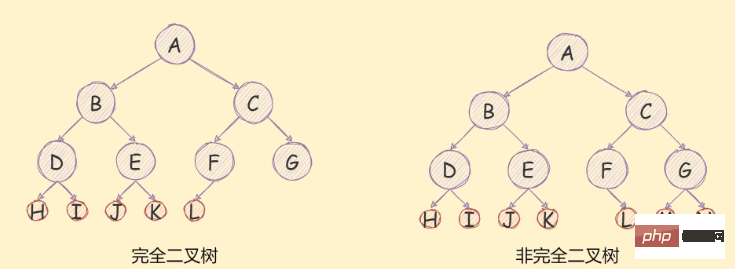
array storage, and the other is to use linked list storage.
Array storageUse arrays to store binary trees. If you encounter a complete binary tree, the storage order is from top to bottom, from left to right, as shown in the following figure:
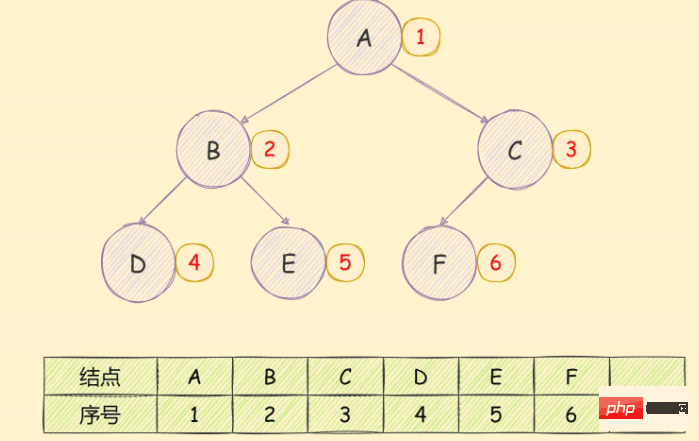
If it is a non-complete binary tree, as shown below:
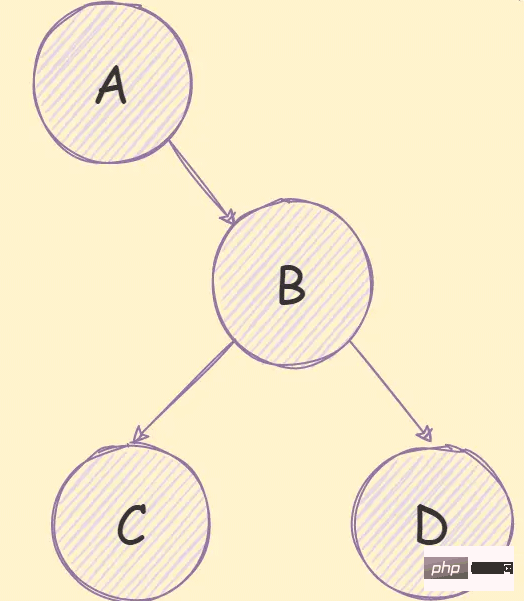
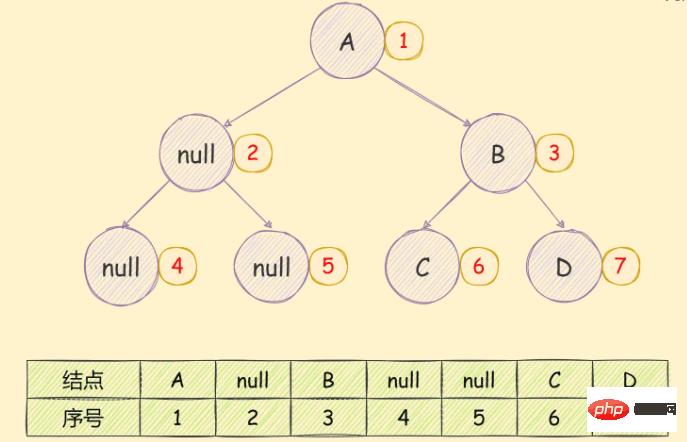 You can clearly see the waste of storage space.
You can clearly see the waste of storage space.
Linked list storage
Using linked list storage, the binary tree is usually divided into 3 parts, as shown below:
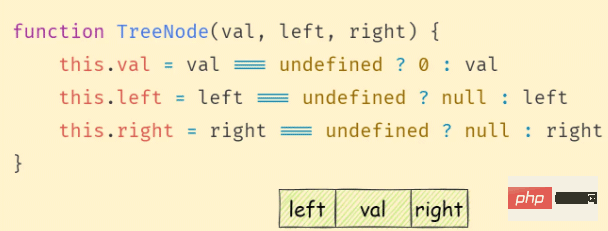
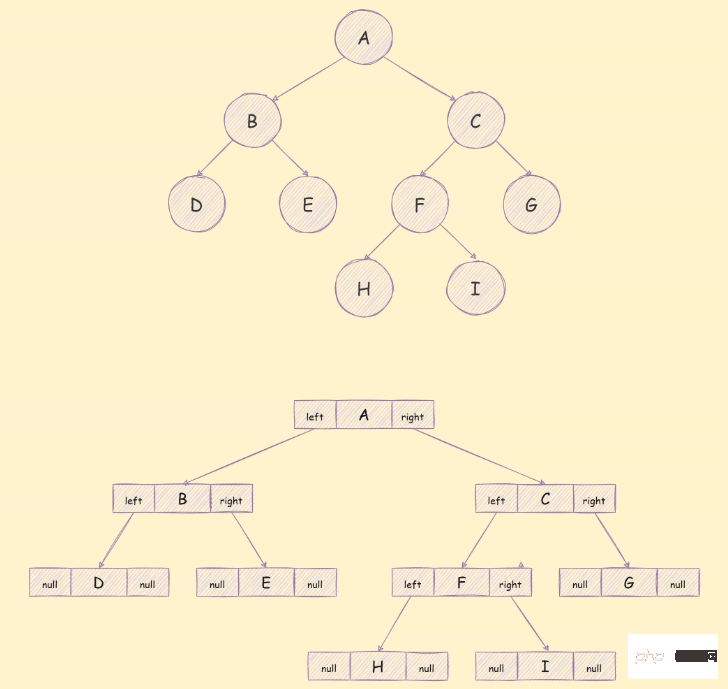 Algorithms related to binary trees
Algorithms related to binary trees
:// tree.js
const bt = {
val: 'A',
left: {
val: 'B',
left: { val: 'D', left: null, right: null },
right: { val: 'E', left: null, right: null },
},
right: {
val: 'C',
left: {
val: 'F',
left: { val: 'H', left: null, right: null },
right: { val: 'I', left: null, right: null },
},
right: { val: 'G', left: null, right: null },
},
}
module.exports = btDepth-first traversal
visits the root node;
const bt = {
val: 'A',
left: {
val: 'B',
left: { val: 'D', left: null, right: null },
right: { val: 'E', left: null, right: null },
},
right: {
val: 'C',
left: {
val: 'F',
left: { val: 'H', left: null, right: null },
right: { val: 'I', left: null, right: null },
},
right: { val: 'G', left: null, right: null },
},
}
function dfs(root) {
if (!root) return
console.log(root.val)
root.left && dfs(root.left)
root.right && dfs(root.right)
}
dfs(bt)
/** 结果
A B D E C F H I G
*/Breadth-first traversal
Create a queue and add the root node to the queue
right at the head of the queue to the queue in sequence function bfs(root) {
if (!root) return
const queue = [root]
while (queue.length) {
const node = queue.shift()
console.log(node.val)
node.left && queue.push(node.left)
node.right && queue.push(node.right)
}
}
bfs(bt)
/** 结果
A B C D E F G H I
*/Pre-order traversal
如下图所示: 递归方式实现如下: 迭代方式实现如下: 二叉树的中序遍历实现思想如下: 如下图所示: 递归方式实现如下: 迭代方式实现如下: 二叉树的后序遍历实现思想如下: 如下图所示: 递归方式实现如下: 迭代方式实现如下: 【相关推荐:javascript视频教程、web前端】
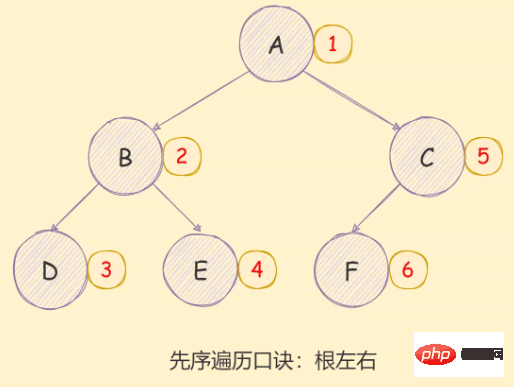
const bt = require('./tree')
function preorder(root) {
if (!root) return
console.log(root.val)
preorder(root.left)
preorder(root.right)
}
preorder(bt)
/** 结果
A B D E C F H I G
*/// 非递归版
function preorder(root) {
if (!root) return
// 定义一个栈,用于存储数据
const stack = [root]
while (stack.length) {
const node = stack.pop()
console.log(node.val)
/* 由于栈存在先入后出的特性,所以需要先入右子树才能保证先出左子树 */
node.right && stack.push(node.right)
node.left && stack.push(node.left)
}
}
preorder(bt)
/** 结果
A B D E C F H I G
*/中序遍历
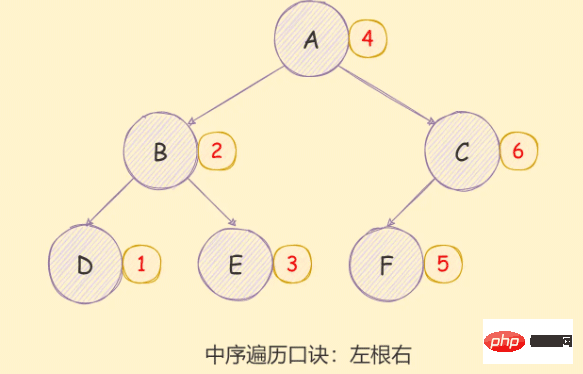
const bt = require('./tree')
// 递归版
function inorder(root) {
if (!root) return
inorder(root.left)
console.log(root.val)
inorder(root.right)
}
inorder(bt)
/** 结果
D B E A H F I C G
*/// 非递归版
function inorder(root) {
if (!root) return
const stack = []
// 定义一个指针
let p = root
// 如果栈中有数据或者p不是null,则继续遍历
while (stack.length || p) {
// 如果p存在则一致将p入栈并移动指针
while (p) {
// 将 p 入栈,并以移动指针
stack.push(p)
p = p.left
}
const node = stack.pop()
console.log(node.val)
p = node.right
}
}
inorder(bt)
/** 结果
D B E A H F I C G
*/后序遍历
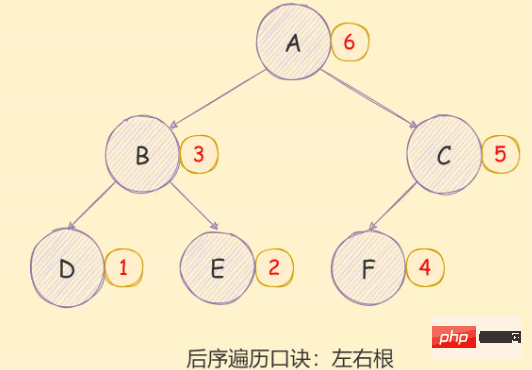
const bt = require('./tree')
// 递归版
function postorder(root) {
if (!root) return
postorder(root.left)
postorder(root.right)
console.log(root.val)
}
postorder(bt)
/** 结果
D E B H I F G C A
*/// 非递归版
function postorder(root) {
if (!root) return
const outputStack = []
const stack = [root]
while (stack.length) {
const node = stack.pop()
outputStack.push(node)
// 这里先入left需要保证left后出,在stack中后出,就是在outputStack栈中先出
node.left && stack.push(node.left)
node.right && stack.push(node.right)
}
while (outputStack.length) {
const node = outputStack.pop()
console.log(node.val)
}
}
postorder(bt)
/** 结果
D E B H I F G C A
*/
The above is the detailed content of Detailed introduction to JavaScript binary trees and various traversal algorithms. For more information, please follow other related articles on the PHP Chinese website!